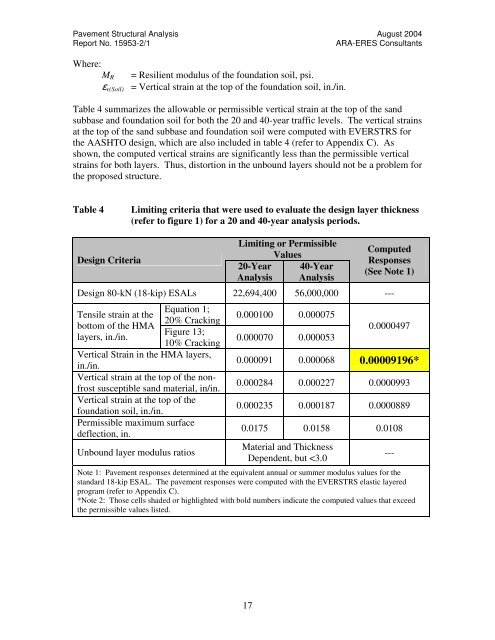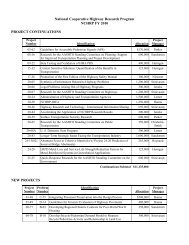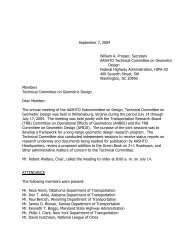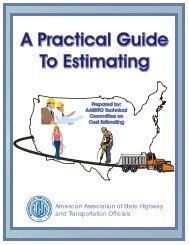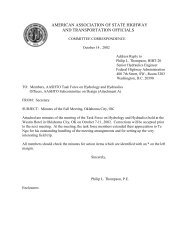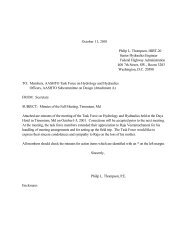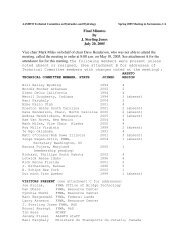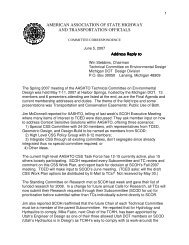Pavement Structural Analysis of the Design Recommendations for ...
Pavement Structural Analysis of the Design Recommendations for ...
Pavement Structural Analysis of the Design Recommendations for ...
You also want an ePaper? Increase the reach of your titles
YUMPU automatically turns print PDFs into web optimized ePapers that Google loves.
<strong>Pavement</strong> <strong>Structural</strong> <strong>Analysis</strong> August 2004<br />
Report No. 15953-2/1 ARA-ERES Consultants<br />
Where:<br />
MR = Resilient modulus <strong>of</strong> <strong>the</strong> foundation soil, psi.<br />
εv(Soil) = Vertical strain at <strong>the</strong> top <strong>of</strong> <strong>the</strong> foundation soil, in./in.<br />
Table 4 summarizes <strong>the</strong> allowable or permissible vertical strain at <strong>the</strong> top <strong>of</strong> <strong>the</strong> sand<br />
subbase and foundation soil <strong>for</strong> both <strong>the</strong> 20 and 40-year traffic levels. The vertical strains<br />
at <strong>the</strong> top <strong>of</strong> <strong>the</strong> sand subbase and foundation soil were computed with EVERSTRS <strong>for</strong><br />
<strong>the</strong> AASHTO design, which are also included in table 4 (refer to Appendix C). As<br />
shown, <strong>the</strong> computed vertical strains are significantly less than <strong>the</strong> permissible vertical<br />
strains <strong>for</strong> both layers. Thus, distortion in <strong>the</strong> unbound layers should not be a problem <strong>for</strong><br />
<strong>the</strong> proposed structure.<br />
Table 4 Limiting criteria that were used to evaluate <strong>the</strong> design layer thickness<br />
(refer to figure 1) <strong>for</strong> a 20 and 40-year analysis periods.<br />
<strong>Design</strong> Criteria<br />
Limiting or Permissible<br />
Values<br />
20-Year 40-Year<br />
<strong>Analysis</strong> <strong>Analysis</strong><br />
17<br />
Computed<br />
Responses<br />
(See Note 1)<br />
<strong>Design</strong> 80-kN (18-kip) ESALs 22,694,400 56,000,000 ---<br />
Equation 1;<br />
Tensile strain at <strong>the</strong><br />
20% Cracking<br />
bottom <strong>of</strong> <strong>the</strong> HMA<br />
Figure 13;<br />
layers, in./in.<br />
10% Cracking<br />
Vertical Strain in <strong>the</strong> HMA layers,<br />
in./in.<br />
Vertical strain at <strong>the</strong> top <strong>of</strong> <strong>the</strong> nonfrost<br />
susceptible sand material, in/in.<br />
Vertical strain at <strong>the</strong> top <strong>of</strong> <strong>the</strong><br />
foundation soil, in./in.<br />
Permissible maximum surface<br />
deflection, in.<br />
Unbound layer modulus ratios<br />
0.000100 0.000075<br />
0.000070 0.000053<br />
0.0000497<br />
0.000091 0.000068 0.00009196*<br />
0.000284 0.000227 0.0000993<br />
0.000235 0.000187 0.0000889<br />
0.0175 0.0158 0.0108<br />
Material and Thickness<br />
Dependent, but


